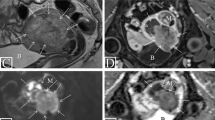Abstract
Objective: The clinical usefulness of FDG-PET in the follow up of post-operative patients with endometrial cancer was retrospectively evaluated.Methods: Twenty-one post-operative patients with endometrial cancer received 30 FDG-PET examinations to evaluate recurrence or response to treatment. The findings of FDG-PET were compared with their serum levels of tumor markers, CT and/or MRI findings, and the final outcome. Results of FDG-PET were also correlated with the clinical course of each patient.Results: In detecting recurrent lesions and evaluating treatment responses, FDG-PET, with the help in anatomic information by CT/MRI, showed better diagnostic ability (sensitivity 100.0%, specificity 88.2%, accuracy 93.3%) compared with combined conventional imaging (sensitivity 84.6%, specificity 85.7%, accuracy 85.0%) and tumor markers (sensitivity 100.0%, specificity 70.6%, accuracy 83.3%). FDG-PET had no false-negative results, suggesting the possibility of its use as the first-line examination in a patient’s follow-up. FDG-PET could detect unknown lesions in 4 cases, and, as reported for other malignancies, FDG-PET affected the patient management in one-third of the cases. Furthermore, the results of FDG-PET correlated well with the clinical outcome of the patients, with patients with negative PET results tending to show disease-free courses.Conclusions: These results suggest that, despite the limited number of patients studied, FDG-PET was accurate in detecting recurrence and evaluating therapeutic response, and could afford important information in the management of post-operative patients with endometrial cancer. FDG-PET also appeared to have a possibility to predict the outcome of each patient.
Similar content being viewed by others
References
Delbeke D, Martin WH. Positron emission tomography imaging in oncology.Radiol Clin North Am 2001; 39: 883–917.
Delbeke D. Oncological applications of FDG PET imaging: brain tumors, colorectal cancer, lymphoma and melanoma.J Nucl Med 1999; 40: 591–603.
Lowe VJ, Fletcher JW, Gobar L, Lawson M, Kirchner P, Valk P, et al. Prospective investigation of positron emission tomography in lung nodules.J Clin Oncol 1998; 16: 1075–1084.
Sugawara Y, Eisbruch A, Kosuda S, Recker BE, Kison PV, Wahl RL. Evaluation of FDG PET in patients with cervical cancer.J Nucl Med 1999; 40: 1125–1131.
Rose PG, Adler LP, Rodriguez M, Faulhaber PF, Abdul-Karim FW, Miraldi F. Positron emission tomography for evaluating para-aortic nodal metastasis in locally advanced cervical cancer before surgical staging: a surgicopathologic study.J Clin Oncol 1999; 17: 41–45.
Zimny M, Siggelkow W, Schroder W, Nowak B, Biemann S, Rath W, et al. 2-[Fluorine-18]-fluoro-2-deoxy-d-glucose positron emission tomography in the diagnosis of recurrent ovarian cancer.Gynecol Oncol 2001; 83: 310–315.
Torizuka T, Nobezawa S, Kanno T, Futatsubashi M, Yoshikawa E, Okada H, et al. Ovarian cancer recurrence: role of whole-body positron emission tomography using 2-[fluorine-18]-fluoro-2-deoxy-d-glucose.Eur J Nucl Med Mol Imaging 2002; 29: 797–803.
Nakamoto Y, Saga T, Ishimori T, Mamede M, Togashi K, Higuchi T, et al. Clinical value of positron emission tomography with FDG for recurrent ovarian cancer.Am J Roentgenol 2001; 176: 1449–1454.
Nakahara T, Fujii H, Ide M, Mochizuki Y, Takahashi W, Yasuda S, et al. F-18 FDG uptake in endometrial cancer.Clin Nucl Med 2001; 26: 82–83.
Belhocine T, De Barsy C, Hustinx R, Willems-Foidart J. Usefulness of18F-FDG PET in the post-therapy surveillance of endometrial carcinoma.Eur J Nucl Med 2002; 29: 1132–1139.
Hamacher K, Coenen HH, Stocklin G. Efficient stereospecific synthesis of no-carrier-added 2-[18F]-fluoro-2-deoxy-d-glucose using aminopolyether supported nucleophilic substitution.J Nucl Med 1986; 27: 235–238.
Kitano H, Magata Y, Tanaka A, Mukai T, Kuge Y, Nagatsu K, et al. Performance assessment of O-18 water purifier.Ann Nucl Med 2001; 15: 75–78.
Irvin WP, Rice LW, Berkowitz RS. Advances in the management of endometrial adenocarcinoma. A review.J Reprod Med 2002; 47: 173–189.
Mariani A, Webb MJ, Keeney GL, Aletti G, Podratz KC. Assessment of prognostic factors in stage IIIA endometrial cancer.Gynecol Oncol 2002; 86: 38–44.
Sakuragi N, Hareyama H, Todo Y, Yamada H, Yamamoto R, Fujino T, et al. Prognostic significance of serous and clear cell adenocarcinoma in surgically staged endometrial carcinoma.Acta Obstet Gynecol Scand 2000; 79: 311–316.
Arulampalam T, Costa D, Visvikis D, Boulos P, Taylor I, Ell P. The impact of FDG-PET on the management algorithm for recurrent colorectal cancer.Eur J Nucl Med 2001; 28: 1758–1765.
Yap CS, Seltzer MA, Schiepers C, Gambhir SS, Rao J, Phelps ME, et al. Impact of whole-body18F-FDG PET on staging and managing patients with breast cancer: the referring physician’s perspective.J Nucl Med 2001; 42: 1334–1337.
Saga T, Ishimori T, Nakamoto Y, Higashi T, Mamede M, Higuchi T, et al. Clinical follow up of patients with gynecological malignancies who underwent FDG-PET without imaging finding of recurrence.J Nucl Med 2001; 42: 285p. (abstract)
Rose PG, Faulhaber P, Miraldi F, Abdul-Karim FW. Positive emission tomography for evaluating a complete clinical response in patients with ovarian or peritoneal carcinoma: correlation with second-look laparotomy.Gynecol Oncol 2001; 82: 17–21.
Author information
Authors and Affiliations
Corresponding author
Rights and permissions
About this article
Cite this article
Saga, T., Higashi, T., Ishimori, T. et al. Clinical value of FDG-PET in the follow up of post-operative patients with endometrial cancer. Ann Nucl Med 17, 197–203 (2003). https://doi.org/10.1007/BF02990022
Received:
Accepted:
Issue Date:
DOI: https://doi.org/10.1007/BF02990022




